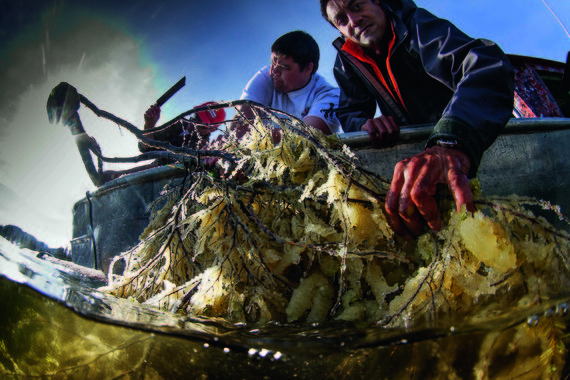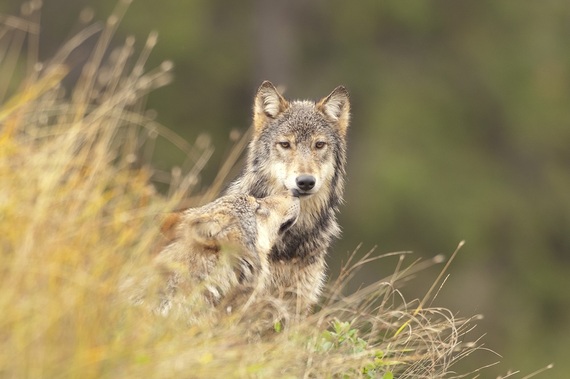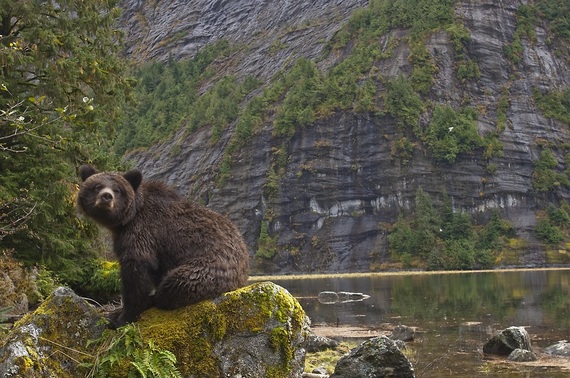If you visit Canada's Great Bear Rainforest -- and you should -- you'd be lucky to have Ian McAllister as your guide. His knowledge of the world's largest remaining coastal temperate rainforest is unparalleled, and his passion for conserving it is contagious.
He's also one of the more resourceful guides I've had. Watching him shimmy up the mast of our rollicking boat on a blustery day to free a tangled sail, I remember thinking, "This is one can-do guy."
Ian brings that energy to the wildlife conservation organization that he co-founded, Pacific Wild. An award-wining photographer and author, he and his wife Karen McAllister were named by Time magazine as "Leaders for the 21st Century" for their efforts to protect British Columbia's endangered rainforest. He lives with his family on an island in the heart of the Great Bear Rainforest.
I recently spoke with Ian on the occasion of the new PBS series EARTH: A New Wild, which explores people's relationship with wildlife in some of the planet's most spectacular places, including the Great Bear Rainforest.
Mark Tercek: What makes the Great Bear Rainforest unique?
Ian McAllister: The largest remaining intact temperate rainforest left on Earth, a fabled region of towering trees and rare mammals, the Great Bear Rainforest stands out as an ecological powerhouse on a planet plagued by diminishing ecological value. The region represents half of Canada's Pacific coast and is comprised of a thousand uninhabited islands, two thousand river valleys hosting wild salmon and one of the largest unexplored, unprotected marine ecosystems on Earth.
Mark Tercek: The forest also has great economic and cultural value. How are those interests connected to environmental considerations in Great Bear?
Ian McAllister: This balance is still being tested, but this coast's greatest asset is that the full suite of flora and fauna are still represented here, and First Nations people are increasingly asserting stewardship authority over land- and marine-use decisions. Yes, abundance of life has been diminished, but this coast represents a tremendous opportunity for achieving a balance between ecosystem function and health with the needs of the small human population that exists here, the point being if we can't make it work here -- a place of untold biological wealth and a small human population -- then it is difficult to imagine that it can be done right anywhere else.
There is great hope for this Great Bear Rainforest if its future is determined by coastal people, both native and non-native, but what complicates our current situation is that most of the ecological stresses are external: global warming, acidification of our ocean and multiple oil and gas proposals that increasingly look to the Great Bear Rainforest as an energy superhighway between the Alberta oil sands and Asia.

Mark Tercek: Why does this place mean so much to you?
Ian McAllister: I live in Heiltsuk First Nation territory, and it is impossible for me to consider anything as beautiful and ecologically productive as this coast. A typical day might see me leaving my house, and within minutes I am traveling with a group of bubble-net-feeding humpback whales, and by day's end I will have observed half a dozen grizzly bears feeding on estuarine sedges, a pack of wolves feasting on herring eggs at low tide and countless other ecological marvels.
It is a place that inspires the best in people. It is a privilege to live here, to raise my family here and be part of the collective effort to protect it through our work with the conservation group Pacific Wild.
Mark Tercek: What lessons can we learn from Great Bear to protect other large forest ecosystems?
Ian McAllister: I can only guess that conservation work in other endangered forests represents a unique set of challenges -- and opportunities. The lesson that I have learned here is that there is no silver bullet in achieving strong conservation outcomes. Rather, it is the diversity of approaches -- science, education, public outreach and engagement, community well-being -- that, when combined, become an integral force leading to meaningful environmental protection.
The other lesson and one that we are still learning here is that protected areas may be a crucial foundation for ecological integrity, but this can quickly unravel without ongoing stewardship, maintenance and evaluation of human impacts.
Mark Tercek: What's your spirit animal?
Ian McAllister: I fell in love with this coast through the eyes of large carnivores, in particular grizzly bears and wolves. It has been an incredible 20-odd-year journey of research, wildlife conservation and first-hand observation of these species. The fascination has not changed but has been enhanced as each new season uncovers more layers showcasing the deep and very old relationship that these species have with this coastal rainforest and the ocean that nourishes it.
I am excited that our long-time friend and colleague M. Sanjayan was able to film and document some of these incredible relationships in the series EARTH A New Wild.
Images (top to bottom): Coastal wolves on the B.C. north coast are genetically distinct, Photo © Ian McAllister; Heiltsuk fishers Jordan Wilson and William Housty show visiting scientists M. Sanjayan the traditional method of harvesting eggs on hemlock boughs during the filming of A New Wild, Photo © Ian McAllister; Coastal grizzly bear, Great Bear Rainforest, Photo © Ian McAllister.


